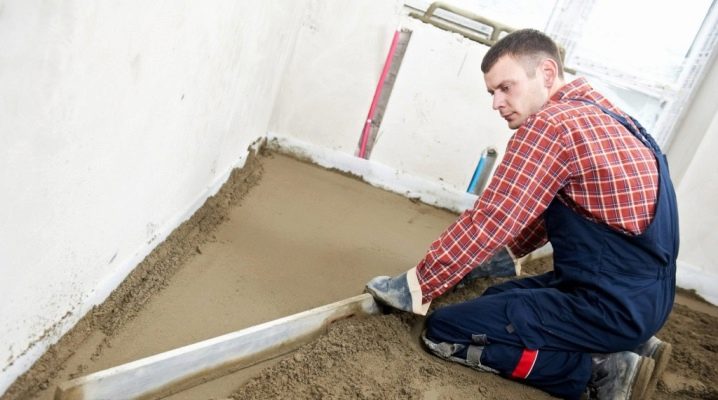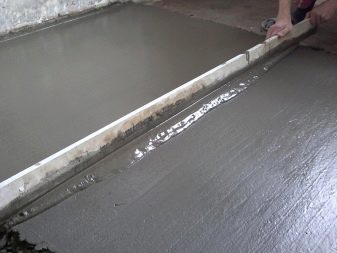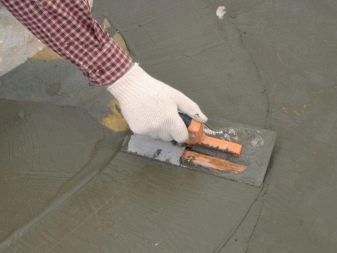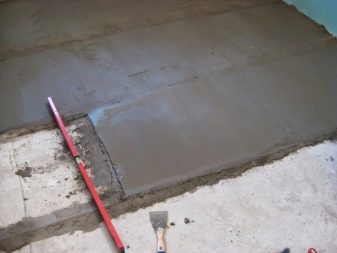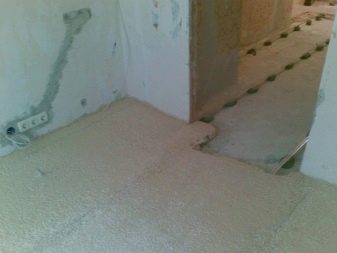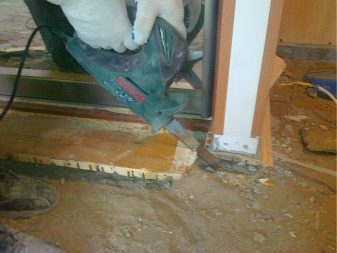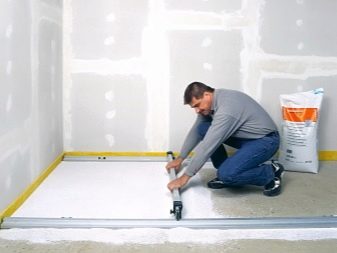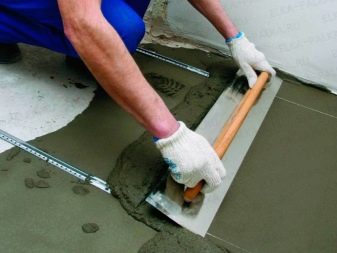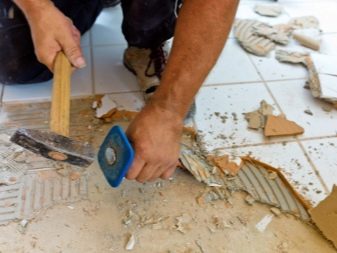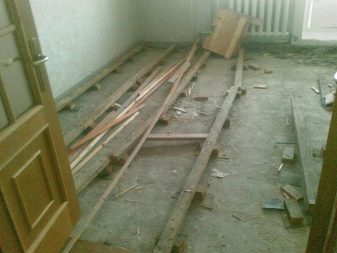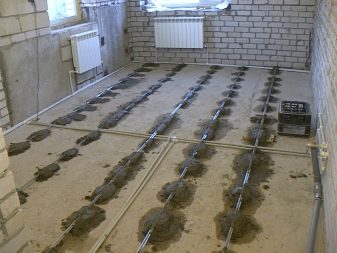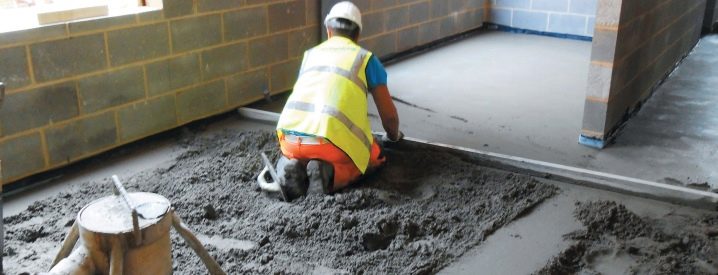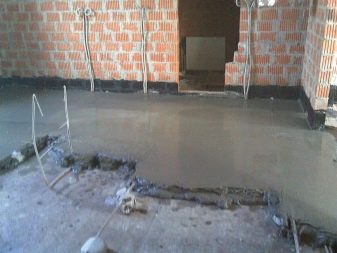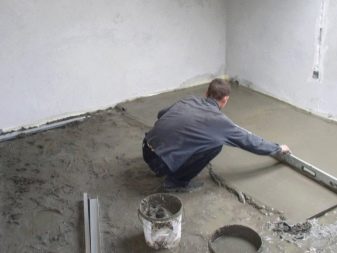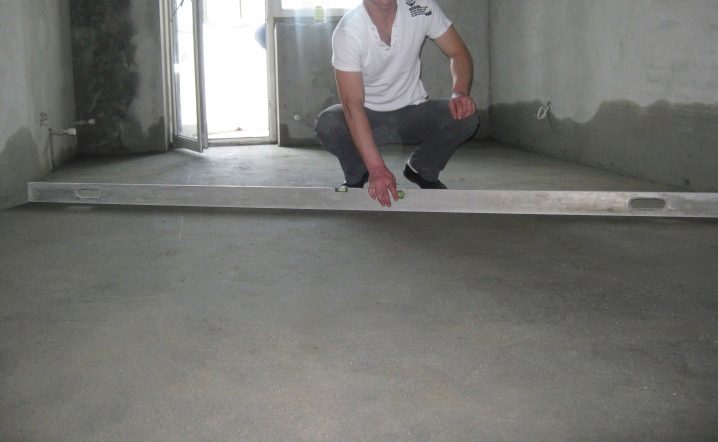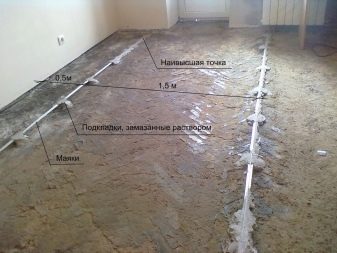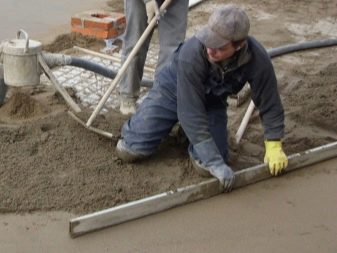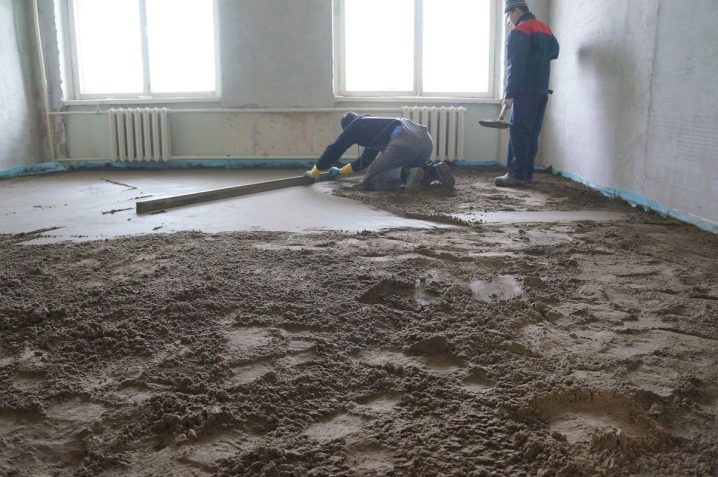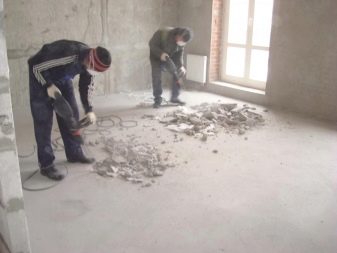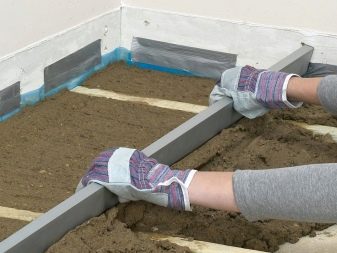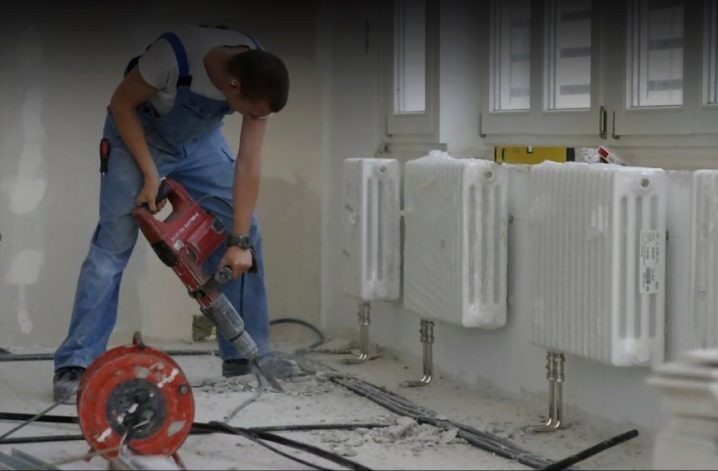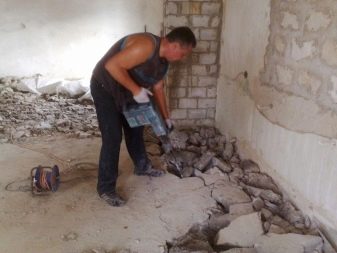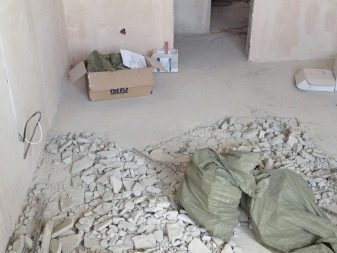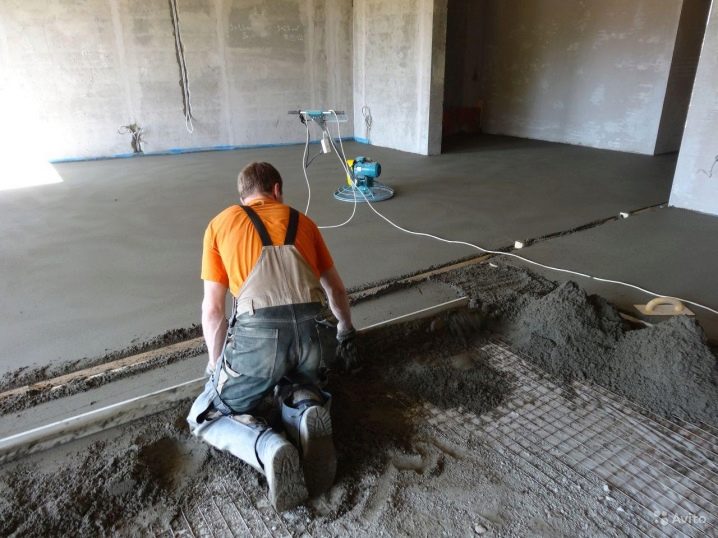Dismantling the old screed when installing the floor
One of the most frequent tasks whose solution requires an overhaul is the dismantling of the old screed. The latter is a layer, which is a kind of "roof", which is located above the supporting ceiling and effectively corrects all its uneven places. If such a foundation is in an unsatisfactory condition, then when installing a new floor, it should be replaced, following the recommendations listed below.
When do you need to remove the screed?
Unfortunately, over time, any basis of flooring will become unusable. This thesis is valid for any materials - as cement-sand mixtures, and for more innovative, belonging to the category of composites. Experience shows that most often the screed requires replacement because of its deformation, which makes further exploitation of the layer extremely problematic.
It is worth noting that in some situations it can be confined to a less radical solution, involving the restoration of the leveling layer without removing it.
As for the cases when the coupler must be dismantled, they provide for the presence of any of the following factors:
- very poor condition of the base of the floor covering, characterized by multiple cracks, gouges, chips and significant differences in height;
- installation of a warm floor and / or restoration of utilities located in the thickness of the leveling layer;
- the inability to fully accommodate the new screed on top of the old one (as a rule, this trouble is inherent in buildings equipped with wooden or combined ceilings).
In addition, the dismantling of the existing base is necessary in situations requiring a lower floor level. In particular, it is necessary for the qualitative connection of dissimilar materials and to reduce to no difference in height between adjacent rooms.
Costing
There are several basic criteria that allow for the calculation of the price for dismantling the floor screed.
These are:
- thickness of the base to be removed;
- number of layers;
- screed material;
- total area of the leveling layer to be removed;
- the presence of reinforced bases or lack thereof.
It is also worth adding that in situations where it is necessary to make an estimate, as a guideline, it is rational to use data from the following regulatory frameworks:
- Collection GESN-11 Floors;
- FER-11 Floor rates;
- Collection TER-11 Floors.
The first base is the State elemental estimate norms, and the other two are the Federal and Territorial unit rates, respectively. When making calculations, it is necessary to take into account the transition index - from the federal prices of 2000 to the current ones.
Preparatory activities
Before proceeding to the procedure of removing the old screed, you need to solve several problems, each of which is important in its own way.
First of all, it is dismantle of decorative floor materials, such as:
- linoleum;
- laminate;
- parquet;
- tile;
- plinth.
All listed elements of finishing must be removed before the start of dismantling. Tile tile operations are the most complex: being planted on cement, it can only be removed with a leveling layer, which implies significant damage to it.
Another important action, which requires preparation for dismantling the screed, is to determine the location of utilities - for example, heating pipes laid in the thickness of the leveling layer. Ignoring this advice is strongly discouraged - in order to avoid distortion of the latter, and sometimes even more serious damage. Special attention should be paid to the search for hidden wiring, not forgetting to de-energize the place of dismantling works in advance.
Inventory used
Choosing a tool, the use of which allows you to professionally solve the problem considered in this material, you first need to take into account the characteristics of the existing screed.
Practice shows that most often in such cases use:
- jackhammers;
- perforators;
- angle grinders ("grinders");
- concrete cutters.
If the contractor considers it justified to carry out the dismantling manually, then it is reasonable for him to acquire the following tools:
- sledgehammer;
- scrap;
- chisel;
- ordinary hammer (suitable only in cases when the repaired room does not have a large area).
As for the ease of removing the screed, the easiest way to get rid of its dry varieties: in most of these situations, only hand tools are enough. But in the case of a semi-dry leveling base, this option cannot be called preferable due to the fact that its composition presumes the presence of durable M500 cement, and sometimes strong reinforcing mesh. It is also reasonable to carry out the dismantling of the “wet” screed using a power tool - a solution that is distinguished by maximum productivity.
Shock method
The considered technique involves breaking off the fragments of the screed and their subsequent removal. To perform such work, the contractor needs a percussive power tool, which can be replaced with a simple sledge hammer or crowbar - provided that the solution of the problem does not require high performance. It should also be noted that the described method is suitable only in cases where the concrete surface is not reinforced with reinforcing elements.
In order to work with a jackhammer or other electric shock tools meet all safety standards, The performer should preferably use the following personal protective equipment:
- respirator;
- overalls from dense material;
- antinoise inserts (“ear plugs”);
- anti-vibration gloves;
- points
In addition, the equipment used must be checked in advance for operation - in order to avoid disruptions in the process of work and other unpleasant consequences.
Performing shock dismantling of the old screed, you need to follow the simple sequence of actions below:
- the tool must be securely fixed in the hands, while choosing the most stable position;
- removing the leveling layer rationally start from the far corner of the room;
- the speed of the equipment used must be increased gradually;
- from the screed, it is desirable to break off as small fragments as possible, moving without haste;
- it is recommended to remove the breakaway pieces of the old base of the floor covering immediately using construction waste bags or other suitable products.
Do not forget that the percussion instrument should be kept only for those areas that are carefully insulated.This precaution helps to avoid the electric shock of the contractor, accidentally hit by a chisel of a jackhammer in a hidden wiring.
Another point, which is necessary in such a situation, is the inevitable heating of the power tools used. In order to avoid the expensive equipment coming out of order, he needs to be given a “breathing space”, the duration of which is sufficient for cooling the equipment. The recommended duration of such breaks is about 5 minutes, after every 10 minutes of the tool.
Removal by cutting
This method is most relevant in situations requiring the dismantling of reinforced screed - leveling layer, reinforced with metal inclusions. In the same method, experts advise to get rid of a certain area of the base of the floor covering, when the remaining areas need to be left intact. A joint cutter is the best choice for such tasks - an electrical device “armed” with a rotating diamond-coated disk. This tool cuts both reinforcement and concrete to a depth limited by the radius of its cutting disc.
If there is no joint cutter, then at home it can be replaced by an ordinary Bulgarian, provided that it is equipped with a diamond-coated disk. This is due to the fact that the standard circle, intended for metal, against concrete is powerless.
To remove the old screed using the described method, you must adhere to the following algorithm:
- removable layer is cut into small fragments;
- the formed pieces are picked out with a crowbar, chisel or other suitable tool;
- all removed fragments of the screed are packed in bags for construction waste.
The main advantage of the presented method of dismantling is a relatively low noise. In addition, it allows you to work more carefully, and therefore does not involve the formation of too much dirt and dust.
But this technique has some drawbacks:
- the high complexity of using a joint cutter, requiring the work to be done by two people;
- the need for a three-phase power supply system capable of providing power up to 14 kW;
- decent equipment cost - both purchases and rentals.
It also makes sense to note that such tools need constant cooling, which requires a full-fledged water supply.
Drill application
Sometimes it happens that the used punch is not able to solve all the tasks assigned to it related to the dismantling of the old screed.
In such cases, you can "help" him by doing the following:
- to get a drill with a diamond tip;
- make as many holes in the concrete;
- split off sections of the leveling layer, drilled from all sides using a peak.
Special attention should be paid to the angle between the drill and the base to be removed. It should be straightforward, which minimizes the chance of damage to the cutting tool used.
Most often, such dismantling is justified in situations where it is necessary to replace not the entire screed, but its specific section. In addition, the described method is the least noisy, and therefore optimally suited for repairs in residential buildings. The only noticeable drawback of this method is the rapid heating of the perforator, which requires regular pauses for its cooling.In part, this problem can be solved by using a second tool with similar performance characteristics.
Other useful tips
In conclusion, it remains to list a few tips on the process of dismantling the old screed:
- in order to avoid destruction of the overlap located under the leveling layer, it is necessary to exclude the possibility of its damage (if necessary, having recourse to the help of specialists);
- all planned activities should be agreed in advance with the neighbors (especially those whose housing is located on the floor below);
- to minimize the amount of dust rising into the air, the floor should be regularly moistened with water;
- all debris generated as a result of the dismantling of the screed must be taken to the designated places.
Having finished the procedure of removing the old leveling layer, you need not only to clean up the garbage and dust in the apartment, but also to make sure that the communications used by the contractor may have affected the integrity of the communications. Next, you can begin to prepare the floor for laying a new screed that meets all the requirements of the owner of the room.
Based on the content of this material, it can be stated that removing the base of the floor covering is a time-consuming, but quite achievable task.
Such a process requires considerable time and effort, but it allows you to gain experience and save financial resources that are never superfluous.
On how to do the dismantling of the old screed when installing the floor, see the following video.
